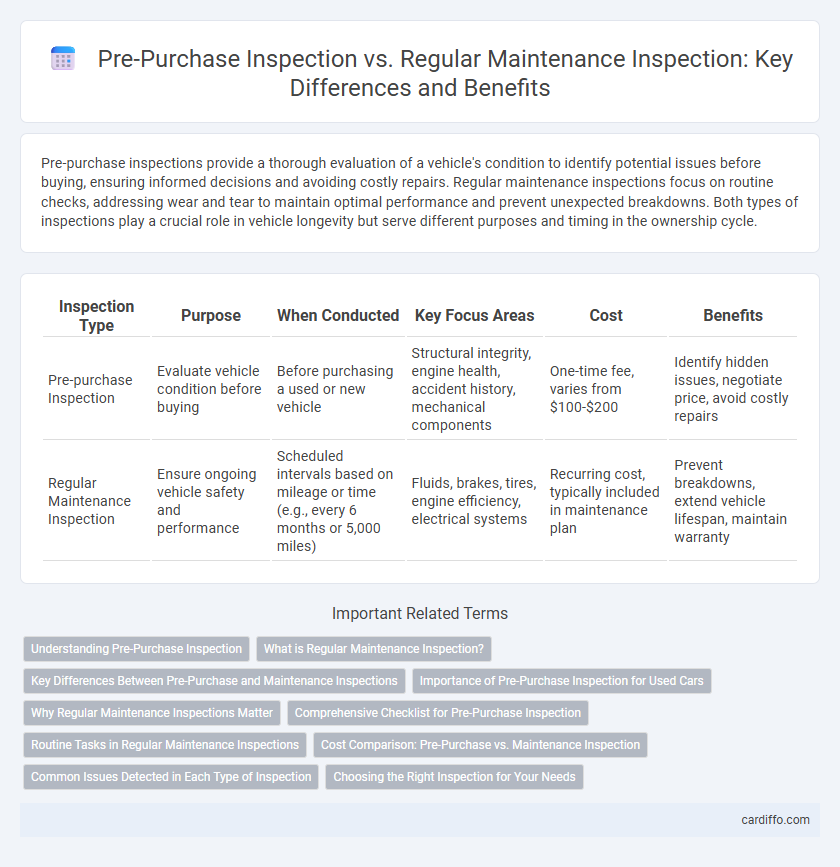Pre-purchase inspections provide a thorough evaluation of a vehicle's condition to identify potential issues before buying, ensuring informed decisions and avoiding costly repairs. Regular maintenance inspections focus on routine checks, addressing wear and tear to maintain optimal performance and prevent unexpected breakdowns. Both types of inspections play a crucial role in vehicle longevity but serve different purposes and timing in the ownership cycle.
Table of Comparison
| Inspection Type | Purpose | When Conducted | Key Focus Areas | Cost | Benefits |
|---|---|---|---|---|---|
| Pre-purchase Inspection | Evaluate vehicle condition before buying | Before purchasing a used or new vehicle | Structural integrity, engine health, accident history, mechanical components | One-time fee, varies from $100-$200 | Identify hidden issues, negotiate price, avoid costly repairs |
| Regular Maintenance Inspection | Ensure ongoing vehicle safety and performance | Scheduled intervals based on mileage or time (e.g., every 6 months or 5,000 miles) | Fluids, brakes, tires, engine efficiency, electrical systems | Recurring cost, typically included in maintenance plan | Prevent breakdowns, extend vehicle lifespan, maintain warranty |
Understanding Pre-Purchase Inspection
Pre-purchase inspection involves a detailed evaluation of a vehicle's condition before finalizing a sale, identifying hidden defects and potential repair costs. This inspection assesses key components such as the engine, transmission, brakes, and frame integrity to ensure the vehicle meets safety and performance standards. Understanding pre-purchase inspection helps buyers make informed decisions and avoid costly surprises after purchase.
What is Regular Maintenance Inspection?
Regular maintenance inspection involves routine checks designed to identify wear and tear, prevent equipment failure, and ensure optimal performance over time. It typically includes verifying fluid levels, examining brake systems, inspecting belts and hoses, and testing electrical components on a scheduled basis. This type of inspection helps maintain vehicle safety, reliability, and longevity by addressing issues before they become major problems.
Key Differences Between Pre-Purchase and Maintenance Inspections
Pre-purchase inspections evaluate a vehicle's overall condition, identifying hidden damages or potential repairs before buying, while regular maintenance inspections focus on ongoing upkeep to ensure optimal performance and safety. Pre-purchase inspections often include detailed assessment of critical components such as engine, transmission, and frame integrity, whereas maintenance inspections emphasize routine checks like oil levels, brake pads, and tire wear. The primary difference lies in the timing and purpose: pre-purchase inspections aim to inform buying decisions, whereas maintenance inspections aim to prevent breakdowns and extend vehicle lifespan.
Importance of Pre-Purchase Inspection for Used Cars
Pre-purchase inspection is crucial for used cars as it thoroughly evaluates the vehicle's condition before ownership transfer, uncovering hidden defects, accident history, and potential future repairs. Unlike regular maintenance inspections, which focus on routine upkeep and immediate safety concerns, pre-purchase inspections provide a comprehensive assessment that helps buyers make informed decisions and avoid costly surprises. This detailed evaluation can significantly protect investment by verifying the car's mechanical integrity and ensuring it meets market standards.
Why Regular Maintenance Inspections Matter
Regular maintenance inspections are essential for identifying potential issues early, ensuring vehicle safety, and extending the lifespan of critical components. Unlike pre-purchase inspections that focus on existing conditions before acquisition, maintenance inspections proactively address wear and tear to prevent costly repairs. Consistent inspections optimize performance, maintain warranty validity, and uphold resell value by preserving the vehicle's overall condition.
Comprehensive Checklist for Pre-Purchase Inspection
A comprehensive checklist for pre-purchase inspections includes verifying the vehicle's structural integrity, engine performance, brake system condition, and electronic component functionality, ensuring no hidden damages or costly repairs. Unlike regular maintenance inspections focused on routine upkeep and wear, the pre-purchase checklist emphasizes identifying prior accident damage, title status, and signs of tampering or fraud. This thorough evaluation minimizes financial risk and informs buyer decisions by highlighting potential future expenses.
Routine Tasks in Regular Maintenance Inspections
Routine tasks in regular maintenance inspections include checking fluid levels, examining brake systems, and inspecting tires for wear and pressure to ensure vehicle safety and performance. These inspections typically involve scheduled oil changes, filter replacements, and battery tests to prevent potential issues. Unlike pre-purchase inspections that focus on identifying hidden defects, regular maintenance inspections prioritize ongoing care and early problem detection.
Cost Comparison: Pre-Purchase vs. Maintenance Inspection
Pre-purchase inspections typically incur a one-time fee ranging from $100 to $300, offering a comprehensive assessment of a vehicle's condition before purchase. Regular maintenance inspections cost less per visit, averaging $60 to $150, but require multiple appointments annually to ensure ongoing vehicle performance and safety. Comparing costs over time, maintenance inspections often exceed pre-purchase inspection expenses due to their recurring nature and scope of services.
Common Issues Detected in Each Type of Inspection
Pre-purchase inspections commonly identify issues such as hidden structural damage, flood damage, and worn suspension components, which are critical for assessing a vehicle's overall condition before buying. Regular maintenance inspections typically detect routine wear and tear items like brake pad wear, fluid leaks, and tire tread depth to ensure ongoing vehicle safety and performance. Understanding the specific issues uncovered in each inspection type helps buyers avoid costly repairs and maintain vehicle reliability over time.
Choosing the Right Inspection for Your Needs
Pre-purchase inspections provide detailed evaluations to identify potential issues before buying a vehicle, focusing on overall condition and hidden defects. Regular maintenance inspections involve routine checks to ensure ongoing safety, performance, and compliance with manufacturer guidelines. Selecting the appropriate inspection depends on whether the goal is to assess a prospective purchase's integrity or to maintain and prolong the lifespan of an owned asset.
Pre-purchase inspection vs regular maintenance inspection Infographic

 cardiffo.com
cardiffo.com